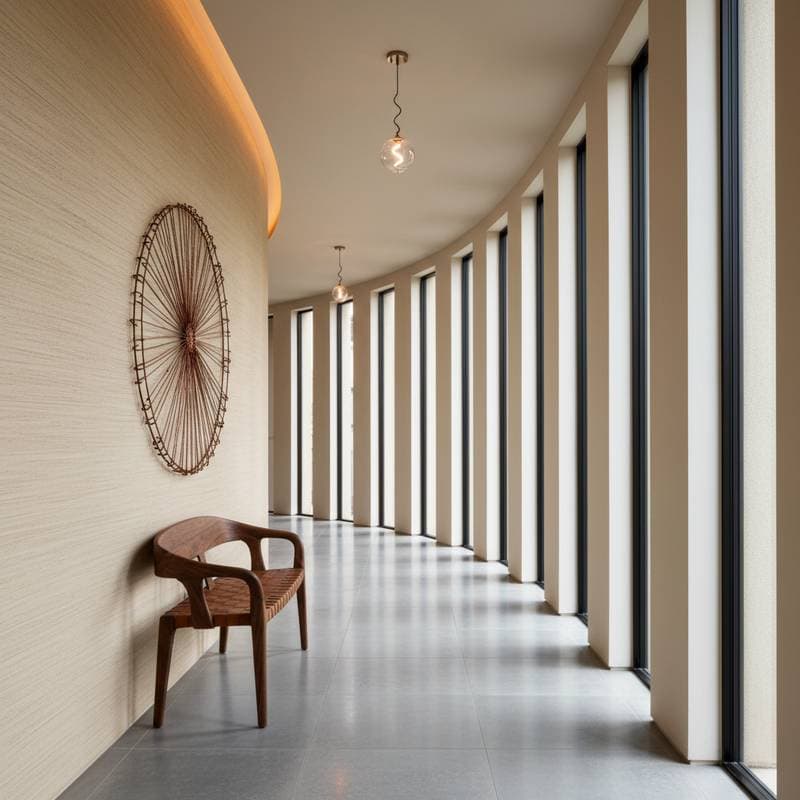The Captivating Essence of Liminal Spaces in Home Design
Individuals have likely traversed a silent hallway in the evening or lingered in an unfurnished room and sensed an indefinable emotion. This blend of tranquility and subtle disquiet represents the liminal sensation in design. It captures the psychological draw of areas poised between states, both physically and perceptually. In residential interiors, this concept gains prominence as residents seek to render transitional zones compelling rather than mundane.
Liminal spaces extend beyond artistic or photographic realms. They permeate every residence, frequently overlooked. Consider a stair landing, mudroom, extended corridor, or loft perimeter; each holds potential for that evocative hush. Rather than viewing these as mere passages, designers regard them as canvases for infusing atmosphere, tactile interest, and introspection into the living environment.
Defining the Liminal Sensation
A liminal space constitutes any locale that evokes an intermediary quality. It may bridge interior and exterior realms, public and private domains, or illumination and obscurity. The resultant emotion ranges from reminiscent to faintly unsettling, shaped by intentional design choices. The intent remains to foster a poised equilibrium, not an atmosphere of spectral unease, but one that prompts contemplation.
From a design perspective, liminality centers on flux. It examines how spatial progression influences feelings. For instance, a corridor that constricts before expanding into a luminous living space, or an entryway illuminated by a solitary diffused pendant, cultivates expectancy. Such instances impart dimensionality to a residence, preventing it from appearing one-dimensional.
Elevating Transitional Areas as Key Design Elements
Homeowners frequently neglect corridors, vestibules, and staircases. These zones often receive neutral white paint and remain unadorned. However, they offer ideal opportunities for cultivating understated ambiance. The following strategies incorporate liminal principles to enhance residential design:
-
Manipulate light and shadow dynamics. Install recessed linear fixtures, wall-mounted sconces, or soft-diffusing luminaires to generate nuanced gradations. Such indirect illumination blurs boundaries and imparts an ethereal ambiance.
-
Prioritize tactile elements over bold hues. Opt for rendered plaster surfaces, subdued ceramic tiles, or organic wood veneers to introduce dimensionality without visual dominance. These materials encourage sensory engagement and decelerate passage through the area.
-
Delineate transitions with purpose. Employ curved portals, sliding panels, or patterned floor inserts to direct flow and denote shifts. This approach imbues a basic juncture with deliberate significance.
-
Maintain spatial clarity. Liminal environments thrive in openness. Select sparse furnishings that resonate with adjacent room palettes, avoiding accumulation.
-
Incorporate evocative artifacts. Integrate period-appropriate artwork, patinated reflectors, or salvaged timber accents to summon recollection and temporality, amplifying the area's affective resonance.
These tactics endow interstitial home sectors with identity and import.
Budgeting and Implementation Insights
Revitalizing transitional zones need not entail comprehensive overhauls. Expenses vary by scope and material quality:
-
Illumination enhancements: Allocate $150 to $600 for fixtures and setup, contingent on electrical intricacies.
-
Surface treatments for texture: Professional application of Venetian plaster or limewash typically costs $4 to $10 per square foot.
-
Structural accents like framing: Bespoke arches or integrated thresholds range from $500 to $2,000, based on selected mediums.
-
Sparsely selected decor: Curated vintage accents often fall between $100 and $400 per item, adding personality without profusion.
For modest endeavors, those with foundational competencies can manage coatings or basic lighting adjustments, provided electricity is disconnected and circuits verified. Substantial modifications, including partition relocations or embedded illuminants, necessitate certified professionals. Verify regional codes for approvals on electrical or constructive alterations.
The Psychological Rewards
The appeal of liminal aesthetics transcends aesthetics; it establishes an emotive cadence. Navigation within a dwelling evolves into a measured interplay of variances. Vibrant, dynamic sectors gain vitality when offset by serene interstitials. A gently illuminated passage affords respite prior to a bustling culinary or communal area.
These locales frequently stir reminiscence. They recall institutional passages, vacant lodgings, or youthful locales where duration seemed halted. This associative link proves potent. Applied judiciously, it anchors contemporary residences in relatable humanity.
Incorporating Liminality in Contemporary Structures
Architects increasingly deploy liminality with precision. Expansive layouts may dissolve divisions, yet strategic pillars, level changes, or vault variations reinstate progression. Transitional building practices merge substances and dimensions to denote motion sans barriers. Transparent dividers, enclosed gardens, and stratified illuminants delineate these evolutions.
Within interiors, practitioners modulate chroma and scale to highlight limens. A shift from chilled aggregate to temperate lumber underfoot heralds a shift to intimate territory. Placement of elements shapes cognition as well. A seating nook atop stairs encourages interim reflection, converting transit into intentional interlude.
Experiencing Liminal Design Daily
When woven with care, liminal zones reshape residential perception and utility. They temper pace, sharpen attentiveness, and infuse routine with nuanced sentiment. Substantial investments prove unnecessary for such outcomes.
The magnetic quality of liminal design resides in its equilibrium of assurance and inquiry. It underscores that elegance flourishes in those hushed, intermediary intervals.
